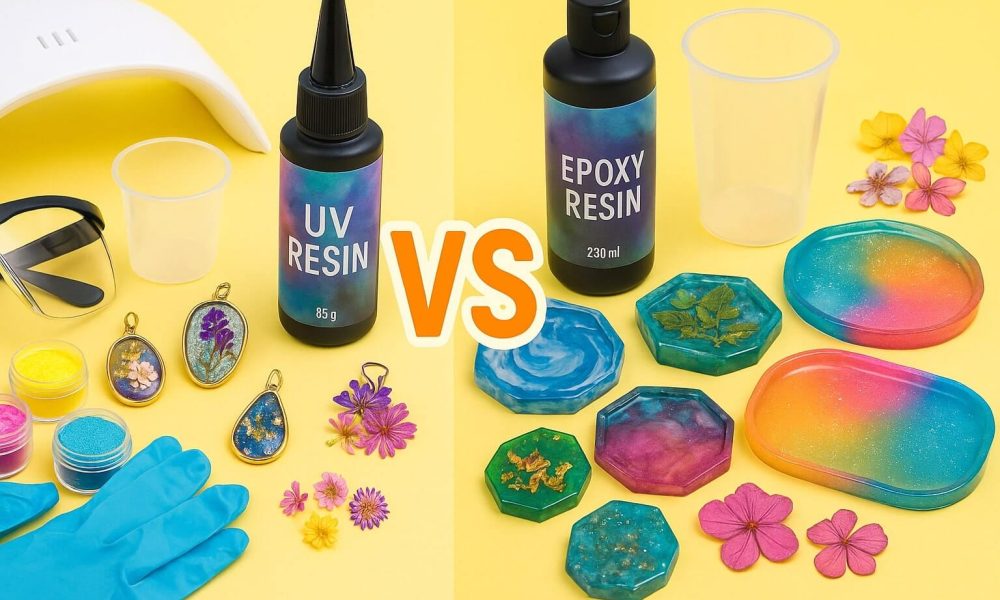UV Resin vs. Epoxy Resin: Key Differences for Beginners
UV Resin vs Epoxy Resin for Beginners: Picture this. You’re holding a crystal-clear pendant filled with delicate flowers or running your fingers over a glossy coaster that looks like it captured the ocean itself. That’s the magic of resin art! If you’re ready to dive into this enchanting world of creativity, you’ve probably hit your first roadblock: “Should I use UV resin or epoxy resin?”
Don’t worry—you’re not alone in this confusion! Every resin artist has stood exactly where you are now, wondering which type of resin will turn their creative dreams into reality. This beginner resin guide demystifies the UV resin vs. epoxy resin debate, helping you confidently choose the perfect resin for your first projects.
Here’s the truth: there’s no universally “best” resin—only the best resin for YOUR specific project. By the end of this guide, you’ll know exactly which one to reach for, whether you’re dreaming of making jewelry, coasters, or anything in between. Let’s turn that overwhelm into excitement!
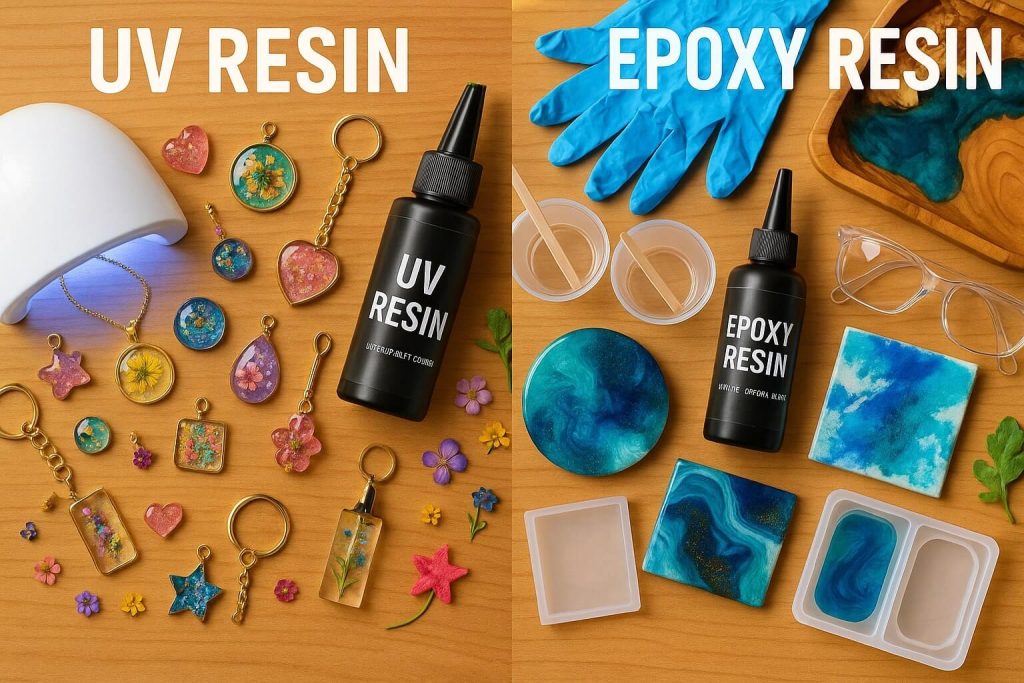
Understanding Epoxy Resin: The Versatile Workhorse
What is Epoxy Resin?
Think of epoxy resin for beginners as a dynamic duo: Part A (the resin) and Part B (the hardener). When you mix these two parts, something magical happens—they start a chemical reaction that generates heat (an exothermic reaction) and gradually transforms from a liquid into a rock-hard, crystal-clear plastic.
This two-part system is the go-to choice for most epoxy resin projects because of its versatility. From tiny jewelry pieces to large serving trays, epoxy resin can handle it all!
Pros of Epoxy for Beginners
- Incredible Versatility: Whether you want to coat a surface, fill a mold, or create something unique, epoxy resin adapts to your vision
- Super Durable: Once cured, epoxy becomes extremely hard and resistant to scratches, making it perfect for items that will see daily use
- Cost-Effective for Volume: When choosing resin for crafts on a budget, epoxy wins—it’s significantly cheaper per ounce than UV resin
- Longer Working Time: You’ll have plenty of time (called resin pot life—usually 20-45 minutes) to add colors, arrange decorations, and perfect your piece before it starts to thicken
Cons of Epoxy for Beginners
- Long Cure Time: Here’s where patience becomes essential—resin cure time for epoxy ranges from 24-72 hours for a complete cure
- Mixing is a Must: Precise measuring and thorough mixing are non-negotiable; get the ratio wrong, and you’ll end up with a sticky mess that never hardens
- Bubbles are Common: The mixing process introduces resin bubbles that you’ll need to remove with a heat gun or torch
- Safety & Fumes: The long curing process means you’ll need good ventilation and protective gear throughout
Best Beginner Projects for Epoxy Resin
- Resin Coasters & Trays
- Small Jewelry Pendants (in silicone molds)
- Bookmarks
- Coating Small Wooden Pieces or Tiles
- Small, Abstract Canvas Art
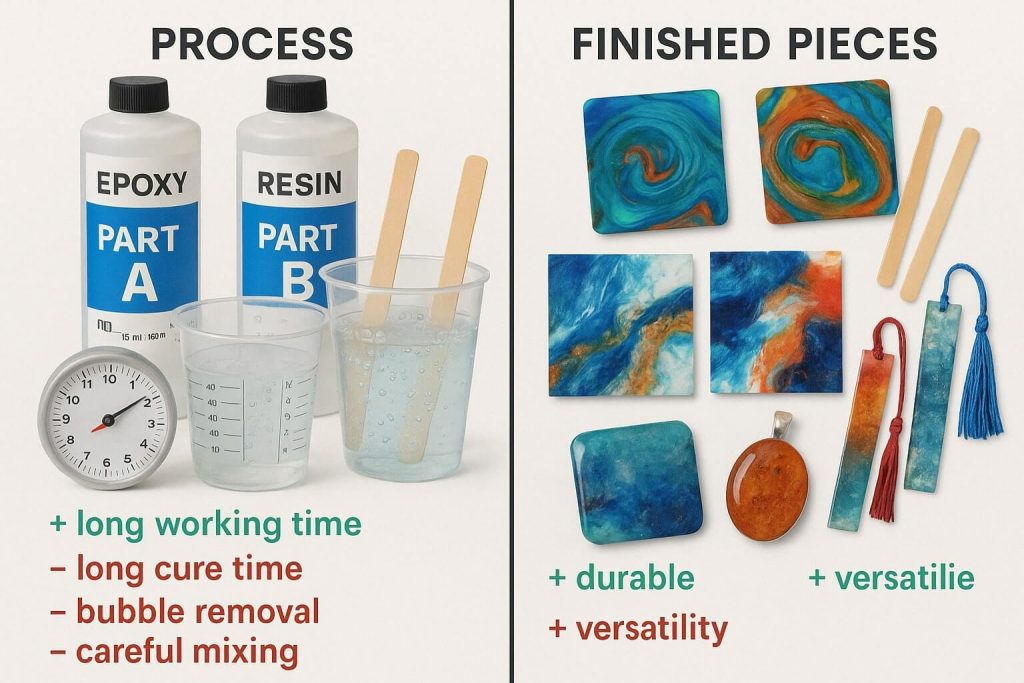
Understanding UV Resin: The Speed Demon
What is UV Resin?
UV resin for beginners is the instant gratification of the resin world! This one-part system comes ready to use straight from the bottle—no mixing required. The secret? It contains a special ingredient called a photoinitiator that springs into action when exposed to ultraviolet light. Shine a UV lamp on your project, and watch it transform from liquid to solid in minutes!
UV resin is specifically designed for speed and precision in small-scale UV resin projects, making it a favorite among jewelry makers and detail-oriented crafters.
Pros of UV Resin for Beginners
- Incredibly Fast Cure: We’re talking 1-5 minutes under a UV lamp—perfect for those who want to see results NOW
- No Mixing Required: Zero measuring, zero mixing, zero math—squeeze and create
- Great for Small Items & Layers: Build up intricate designs layer by layer without waiting hours between applications
- Less Mess & Waste: Use only what you need; the rest stays fresh in the bottle for next time
Cons of UV Resin for Beginners
- Requires a UV Lamp: This essential tool is an additional investment (though you can find affordable options)
- More Expensive per Ounce: UV resin costs significantly more than epoxy, making it impractical for large projects
- Limited Pour Depth: You can only work in thin layers (3-4mm max)—thick pours won’t cure properly underneath
- Can Be Tacky: Insufficient curing time or weak UV light can leave your pieces feeling sticky
- Limitations with Color/Molds: Dark colors and opaque molds can block UV light, preventing proper curing
Best Beginner Projects for UV Resin
- Jewelry in Open-Backed Bezels
- Small Charms and Pendants (in precise, shallow silicone molds)
- Applying a “domed” top coat to flat items (doming resin technique)
- Sealing glitter on keychains or phone grips
- Creating layered effects with inclusions like dried flowers
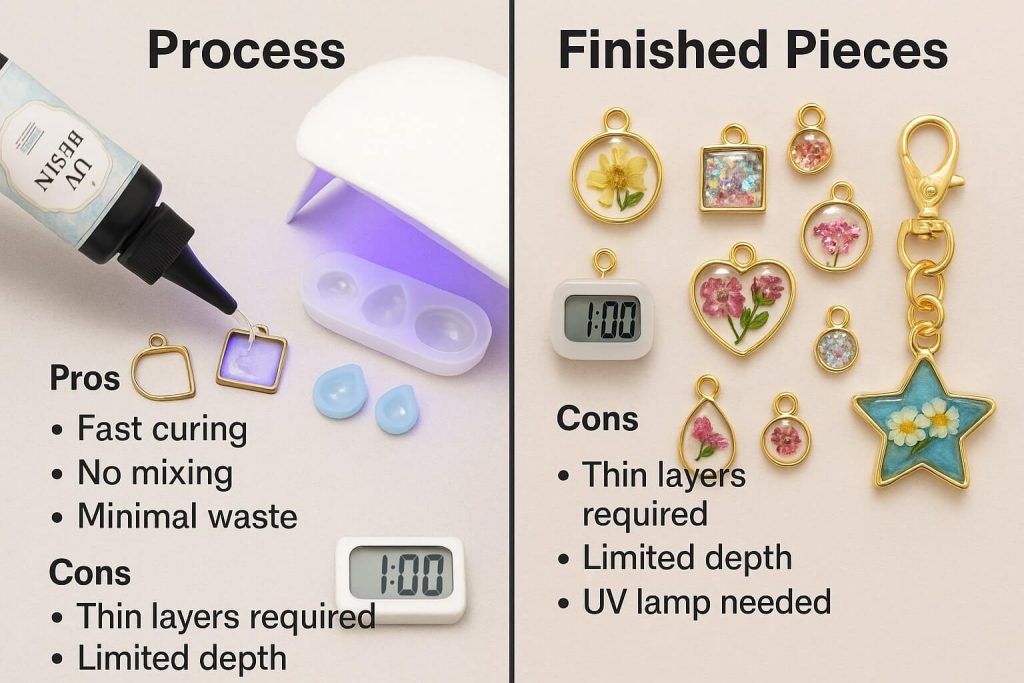
Head-to-Head: UV Resin vs. Epoxy Resin at a Glance
Here’s your quick-reference cheat sheet for what resin to use for beginners:
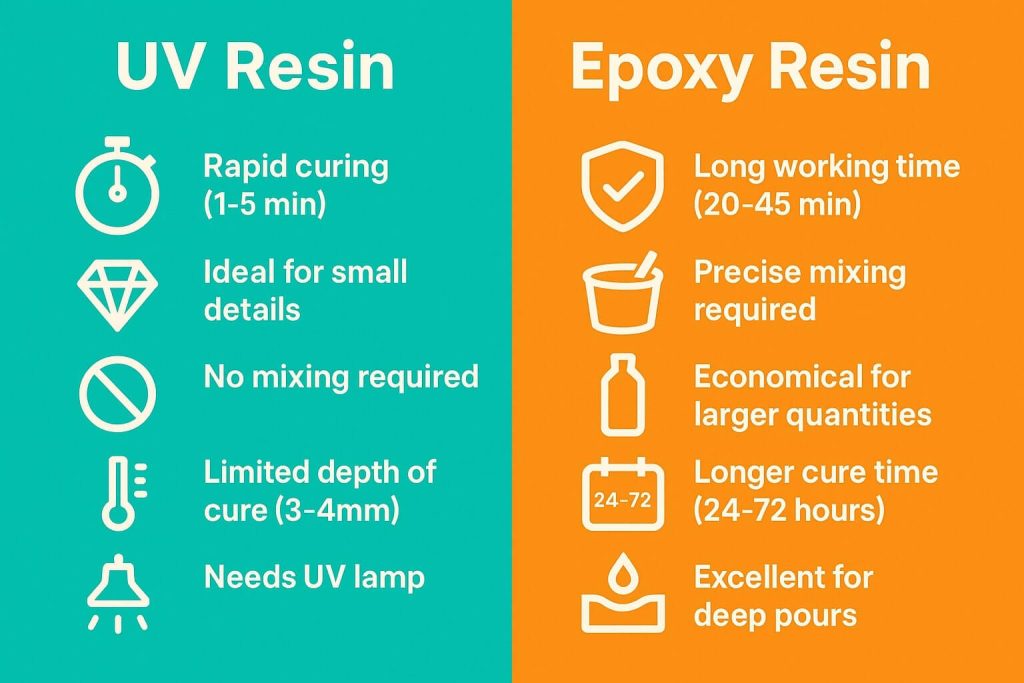
| Feature | Epoxy Resin | UV Resin |
| Mixing | Required (2 Parts) | Not Required (1 Part) |
| Cure Time | 24-72 hours | 1-5 minutes |
| Working Time / Pot Life | 20-45 minutes | Unlimited (until UV exposure) |
| Required Equipment | Mixing cups, sticks, PPE | UV Lamp, PPE |
| Cost per Ounce | Lower | Higher |
| Max Pour Depth | Can be deep (varies by brand) | Very Shallow (3-4mm) |
| Durability | Very High / Strong | Good / Can be more brittle |
| Bubbles | Common from mixing | Fewer (but can occur) |
| Beginner Friendliness | Moderate (mixing required) | Very High (no mixing) |
Essential Resin Concepts Explained
Cure Time vs. Working Time (Pot Life): Don’t confuse these two! Resin working time (or pot life) is how long you must work with mixed epoxy before it gets thick and unusable—usually 20-45 minutes. Cure time is how long until your piece is completely hard—24-72 hours for epoxy, 1-5 minutes for UV resin.
Viscosity (Thick vs. Thin): Resin viscosity is just a fancy word for thickness. Think honey (thick) versus water (thin). Thin resins flow into detailed molds beautifully, while thick resins are perfect for coating surfaces or creating that gorgeous doming effect—a curved, magnifying top layer.
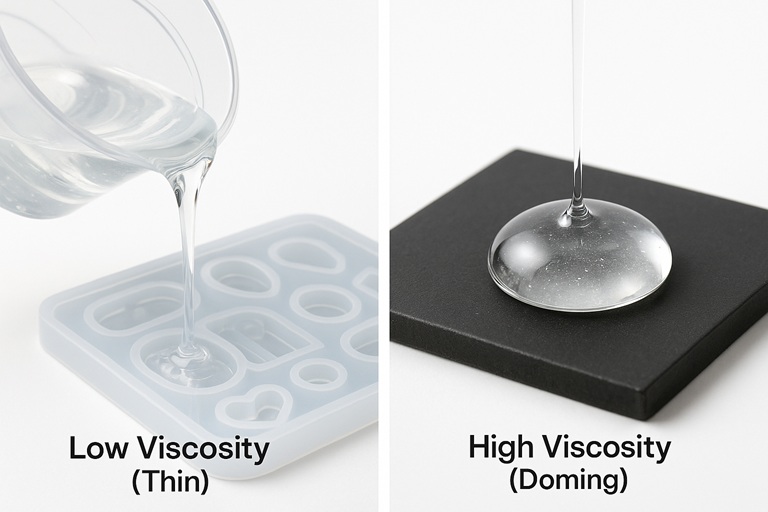
Bubbles: Those pesky resin bubbles! Epoxy gets them from mixing air into the resin, while UV resin can trap them if you pour too quickly. For epoxy, a heat gun or kitchen torch pops them like magic. For UV resin, a toothpick does the trick.
Yellowing: Let’s talk about resin yellowing—all resins can develop a yellow tint over time when exposed to UV light. Look for brands labeled with “UV inhibitors” or “HALS” (Hindered Amine Light Stabilizers) for better long-term clarity.
Your Guide to Resin Safety (A Non-Negotiable!)
The Golden Rules for ALL Resin
Resin safety for beginners isn’t scary—it’s empowering! Following these simple rules ensures you’ll enjoy this hobby for years to come:
- Wear Nitrile Gloves: Always, always, ALWAYS protect your skin from uncured resin
- Wear Safety Glasses: One splash is all it takes—protect those peepers!
- Work in a Well-Ventilated Area: This is THE most important rule. Open windows, use fans, and keep that fresh air flowing.
Specifics for Epoxy Resin
Because epoxy takes so long to cure, you’re exposed to fumes for an extended period. If your workspace ventilation isn’t ideal or you’re sensitive to smells, consider wearing a respirator with organic vapor cartridges. Your lungs will thank you!
Specifics for UV Resin
While UV resin fumes dissipate faster, ventilation remains crucial. Here’s a key safety tip many beginners miss: protect your skin and eyes from UV light! Never look directly into your UV lamp—it’s like staring at the sun.
Clean Up & Disposal
- Wipe up uncured resin immediately with paper towels and isopropyl alcohol
- NEVER pour any resin down the drain—it will cure in your pipes!
- Let paper towels with resin residue cure thoroughly before disposal.
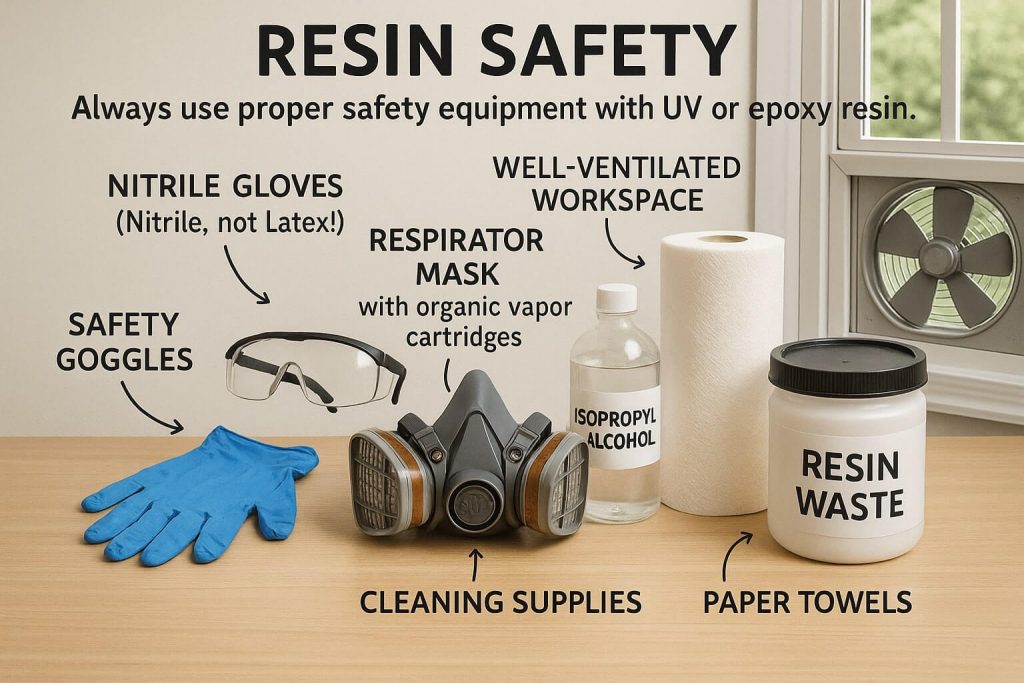
How to Choose: Which Resin is Right for YOU?
Still wondering about choosing resin for crafts? Let’s make it simple:
Choose EPOXY Resin if…
- You want to make larger items like trays, cutting boards, or sets of coasters
- You’re on a tighter budget for materials and want more bang for your buck
- You need maximum durability and heat-resistant resin for functional items
- You enjoy a slower, more methodical process and find the waiting meditative
Choose UV Resin if…
- You crave instant gratification and want to complete projects in one sitting
- You’re focused on small jewelry, charms, or keychains
- The thought of mixing chemicals precisely makes you break out in a cold sweat
- You have limited space and need to minimize the mess and storage of curing projects
Your Resin Journey Starts Now!
So there you have it—the complete lowdown on UV resin vs. epoxy resin! Remember, epoxy is your versatile, durable workhorse that requires patience, while UV resin is your speedy specialist for small, detailed work.
Neither is “better”—they’re tools for different creative visions. Many resin artists eventually use both, choosing the right one for each project. But for now, armed with this knowledge and a healthy respect for safety, you’re ready to pick your path and start creating.
Don’t forget to stock up on your resin supplies—whichever type you choose; you’ll need molds, colorants, and those all-important safety items. Most importantly, remember that every expert resin artist was once exactly where you are now. Be patient with yourself, embrace the learning process, and get ready to create something amazing.
Welcome to the wonderful, magical, and addictive world of resin art. Your creative journey starts with that first pour, so what are you waiting for? Let’s make something beautiful!

